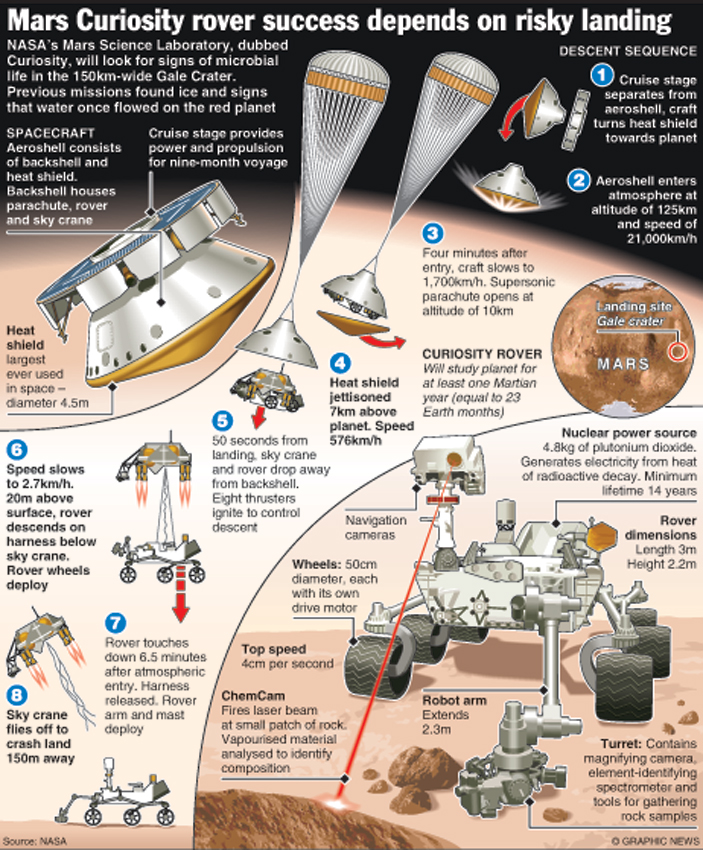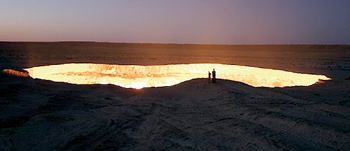Sunday Times 2
Mars fever: NASA faces moment of truth
It is one of the most daring space missions ever attempted.Early on monday morning the Curiosity rover will, if all goes according to plan, enter the martian atmosphere and begin a series of hugely complex manoeuvres to bring it gently onto the surface.
They include a radical floating ‘sky crane’ as part of a descent dubbed the ‘seven minutes of terror’.
But the plucky rover won’t be alone – across the globe, thousands are expected to watch online and on TV as it approaches the red planet.
Nasa has even done a deal to show it in Times Square, while space fans elsewhere are planning parties.
‘In the city that never sleeps, the historic Times Square will be the place for New Yorkers to participate in this historic landing,’ John Grunsfeld, NASA’s associate administrator for science missions, said.
When you think of all the big news events in history, you think of Times Square, and I can think of no better venue to celebrate this news-making event on Mars.’
The Curiosity rover has taken the public’s imagination by storm, in one of the most daring space missions ever attempted.
The rover, Curiosity, is designed to search for clues about possible past life in a crater that might once have been filled with water.
The £1.59 billion six-wheeled machine is twice as long and five times as heavy as the twin rovers Spirit and Opportunity which landed on Mars in 2004.Two British scientists are members of the team which will direct the rover and analyse the data it collects.
Dr John Bridges, from the University of Leicester Space Research Centre, one of the British scientists working on the Mars Science Laboratory mission, said: ‘I’m cautiously optimistic. ‘Space exploration is not for the faint hearted.
‘The previous rover landing used inflatable bouncing bags. Curiosity’s just too heavy for that, so they developed the sky crane technique.’
Curiosity’s target is Gale Crater, near the Martian equator, where there are geological signs of past water. The plan is to land close to Mount Sharp, a 5.5-kilometre peak in the centre of the crater with clay deposits around its base.
If all goes well the radio signal confirming that Curiosity has landed will arrive on Earth after a 14-minute journey through space at 06.31, UK time.
For one Martian year – 98 Earth weeks – Curiosity will explore its surroundings using its robot arm and a formidable array of scientific instruments to analyse samples drilled from rocks or scooped from the ground.It also carries a laser capable of zapping rocks up to 30 feet away, vaporising tiny amounts of material in a flash of light that can be analysed to reveal chemical data.
As well carrying a stereo camera to take panoramic shots, Curiosity will be equipped with a magnifying imager that can reveal details smaller than the width of a human hair.Geologist Professor Sanjeev Gupta, from Imperial College London, the other British scientist involved in the mission, said: ‘Nasa chose Gale Crater as the landing site because it has a number of really exciting geological features that we are hoping to explore.
‘These include a canyon and what appears to be a lake bed on the floor of the crater, as well as a channel and a delta, which we think may have been carved by water.
‘We will use the rover’s cameras, including one which is like a powerful magnifying glass, to study the geology up close.’
Dr Bridges and Prof Gupta will be based at Nasa’s Jet Propulsion Laboratory in Pasadena, California, during the mission.
They will be among hundreds of scientists who will work together round the clock analysing data beamed back from Curiosity, planning experiments and guiding the rover’s excursions.
Dr Bridges said a key goal is to study the clay sediments at the foot of Mount Sharp. Scientists believe they are a reminder of a time, three to four billion years ago, when there was abundant water on the surface of Mars.’The clay layers may represent what we loosely call a warm and wet period in Martian history,’ said Dr Bridges.
‘On the top of the mountain the rock was deposited under dry conditions, so there was a great environmental change.
‘There’s this idea that Mars was warm and wet long ago, but we don’t know how long there were standing bodies of water on Mars, whether they were short lived or lasted hundreds of millions of years.
‘That’s important to the question of whether life ever existed there. Although we’ve made enormous strides in understanding Mars over the last 10 or 20 years, there’s still a lot we don’t know.’An Atlas V rocket carrying Curiosity blasted off from Cape Canaveral, Florida, in November.
The journey to Mars crossed 352 million miles of space.
 |
© Daily Mail, London
comments powered by Disqus






















